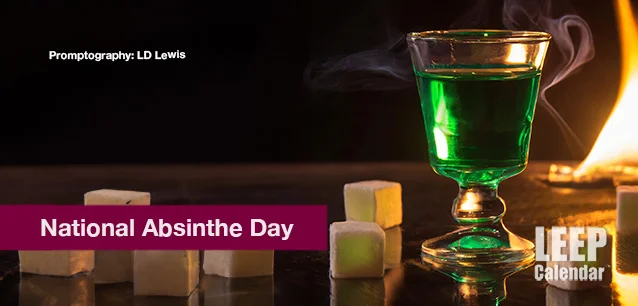 AD
AD
Today is: November 24
Scroll to explore events active on this date.
LEEP INK FEATURES

August is Appropos
A toddler playing in the fountain at a park in Santa Fe, New Mexico—Photo LD Lewis. In August, we live through the Dog Days of Summer. It's hot and often humid, and those ...

September is Sassy
Can you hear that sigh of relief from parents worldwide? Yes! September marks the return of students to school, a global phenomenon. Preparations for the ACT and SATs begin earnestly for ...

OOH LA LA, October
October is the busiest month for events, with 5% more happening than in May, the second most eventful month. Sailing enthusiasts will be glued to the finals of this year's Am...
About National Absinthe Day
United States
Ends: Mar 05, 2024
DESCRIPTION:
Absinthe Day: Celebrating a Storied Spirit
Absinthe Day, observed annually on March 5th, celebrates the enigmatic and historically controversial spirit known as absinthe. This day is not just a toast to the spirit's unique flavor but also a recognition of its tumultuous history and cultural significance.
Absinthe, often referred to as "The Green Fairy" due to its typical green color, is a highly alcoholic beverage derived from botanicals, including the flowers and leaves of Artemisia absinthium (wormwood), green anise, sweet fennel, and other medicinal and culinary herbs.
Originating in the late 18th century, absinthe became popular among artists and writers in the 19th and early 20th centuries, particularly in France.
The production of absinthe begins with distilling a neutral spirit with a blend of herbs, primarily wormwood, anise, and fennel. This distillation process infuses the alcohol with the flavors of these botanicals. The resulting spirit is often colored naturally with other herbs to achieve its characteristic green hue.
However, absinthe's rise to fame was met with controversy. By the early 1900s, it became associated with hallucinogenic properties, mainly due to the chemical compound thujone found in wormwood. This association led to widespread absinthe bans in many countries, including the United States and much of Europe. It wasn't until the 1990s and early 2000s that these bans began to be lifted, following new evidence showing that absinthe was no more harmful than any other high-proof alcoholic spirits.
Popular drinks that include absinthe use it in a small amount due to its strong flavor and high alcohol content. The most classic way to enjoy absinthe is in the traditional French or Swiss preparation, where water is slowly dripped over a sugar cube into a glass of absinthe, resulting in a diluted, less potent beverage. The Sazerac, a famous New Orleans cocktail, is another notable drink with a rinse of absinthe. The Corpse Reviver #2 and the Absinthe Frappé are other well-known cocktails that showcase this unique spirit.
Absinthe Day is an occasion for enthusiasts to celebrate the spirit's rich history and complex flavor profile. It's a day for revisiting Paris's artistic and bohemian scenes and appreciating the spirit that once inspired many legendary artists and writers. The day also serves as a reminder of the evolution of societal attitudes towards alcohol and the importance of evidence-based policy in regulating such beverages.
VIDEOS
SUPPORTING DOCUMENTS
Currently, this event does not have supporting documents.
ADDITIONAL IMAGES
Currently, this event does not have supporting images.
Where would you like to go now?
 AD
AD


/footer-logo.svg)
